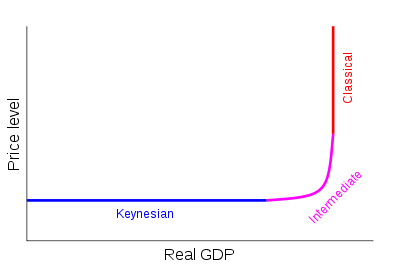Aggregate supply

In economics, aggregate supply (AS) or domestic final supply (DFS) is the total supply of goods and services that firms in a national economy plan on selling during a specific time period. It is the total amount of goods and services that firms are willing and able to sell at a given price level in an economy.
Analysis
There are two main reasons why the amount of aggregate output supplied might rise as P rises, i.e., why the AS curve is upward sloping:
- The short run AS curve is drawn given some nominal variables such as the nominal wage rate, which is assumed fixed in the short run. Thus, a higher price level P implies a lower real wage rate and thus an incentive to produce more output. In the neoclassical long run, on the other hand, the nominal wage rate varies with economic conditions. (High unemployment leads to falling nominal wages which restore full employment.) Hence in the long run the aggregate supply curve is vertical.
- An alternative model starts with the notion that any economy involves a large number of heterogeneous types of inputs, including both fixed capital equipment and labor. Both main types of inputs can be unemployed. The upward-sloping AS curve arises because (1) some nominal input prices are fixed in the short run and (2) as output rises, more and more production processes encounter bottlenecks. At low levels of demand, there are large numbers of production processes that do not use their fixed capital equipment fully. Thus, production can be increased without much in the way of diminishing returns and the average price level need not rise much (if at all) to justify increased production. The AS curve is flat. On the other hand, when demand is high, few production processes have unemployed fixed inputs. Thus, bottlenecks are general. Any increase in demand and production induces increases in prices. Thus, the AS curve is steep or vertical.
Aggregate supply is targeted by government "supply side policies" which are meant to increase productive efficiency and hence national output. Some examples of supply side policies include: education and training, research and development, supporting small/medium entrepreneurs, decreasing business taxes, making labor market reforms to diminish frictions that may hold down output, and investing in infrastructure.
Different scopes
There are generally three alternative degrees of price-level responsiveness of aggregate supply. They are:
- Short run aggregate supply (SRAS) — During the short-run, firms possess one fixed factor of production (usually capital), and some factor input prices are sticky. The quantity of aggregate output supplied is highly sensitive to the price level, as seen in the flat region of the curve in the above diagram.
- Long run aggregate supply (LRAS) — Over the long run, only capital, labour, and technology affect the LRAS in the macroeconomic model because at this point everything in the economy is assumed to be used optimally. In most situations, the LRAS is viewed as static because it shifts the slowest of the three. The LRAS is shown as perfectly vertical, reflecting economists' belief that changes in aggregate demand (AD) have an only temporary change on the economy's total output.
- Medium run aggregate supply (MRAS) — As an interim between SRAS and LRAS, the MRAS form slopes upward and reflects when capital as well as labor usage can change. More specifically, medium run aggregate supply is like this for three theoretical reasons, namely the Sticky-Wage Theory, the Sticky-Price Theory and the Misperception Theory. The position of the MRAS curve is affected by capital, labor, technology, and wage rate.
In the standard aggregate supply–aggregate demand model, real output (Y) is plotted on the horizontal axis and the price level (P) on the vertical axis. The levels of output and the price level are determined by the intersection of the aggregate supply curve with the downward-sloping aggregate demand curve.
See also
- Aggregate demand
- Aggregation problem
- Disequilibrium
- Economic surplus
- Effective demand
- Excess demand
- Excess demand function
- Excess supply
- Induced demand
- Keynesian formula
- Reproduction
- Scarcity
- Supply and demand
- Supply shock
References
- Krugman, Paul (2007). Essentials of Economics. New York: Worth. ISBN 0716758792.
External links
- Elmer G. Wiens: Classical & Keynesian AD-AS Model - An on-line, interactive model of the Canadian Economy